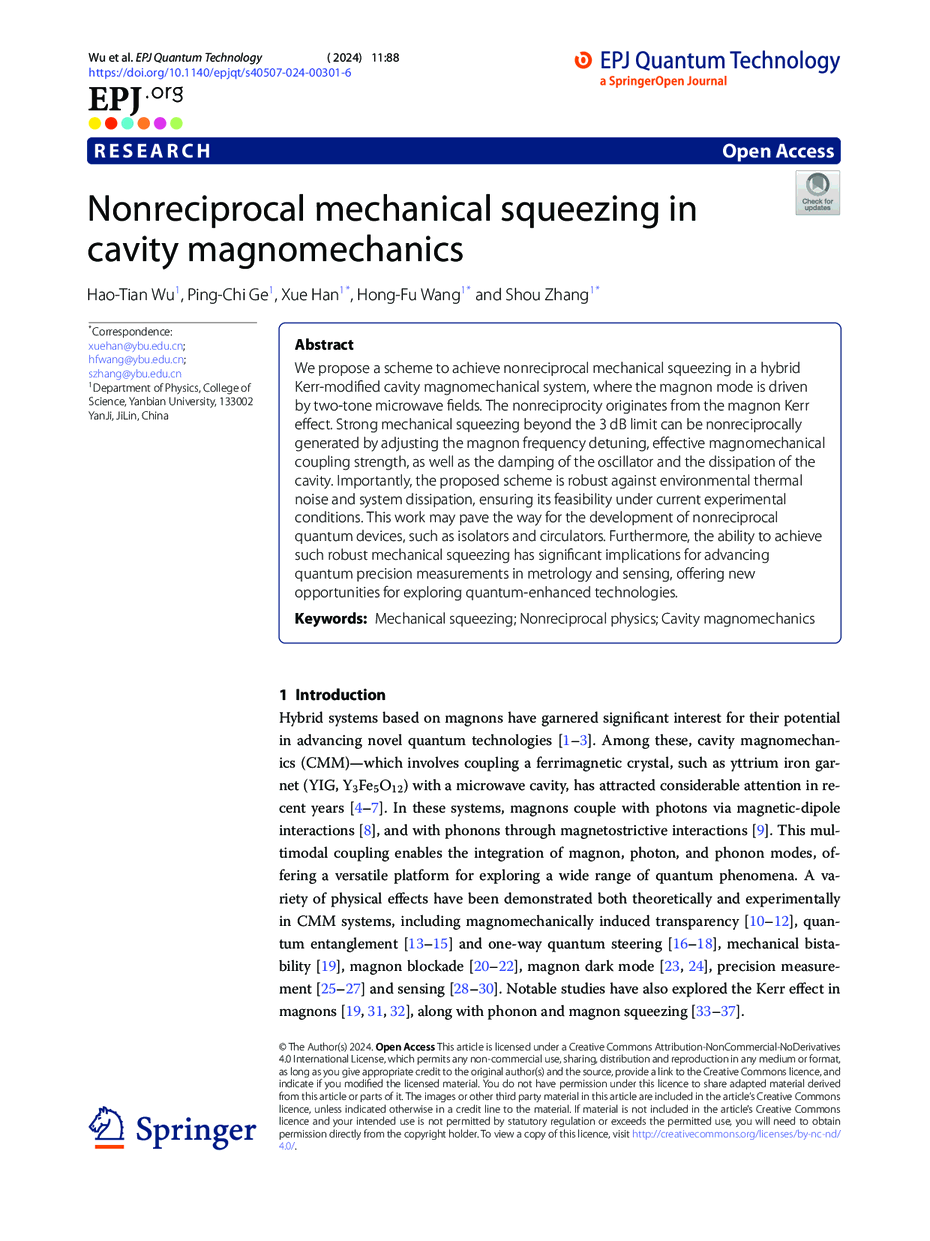https://doi.org/10.1140/epjqt/s40507-024-00301-6
Research
Nonreciprocal mechanical squeezing in cavity magnomechanics
Department of Physics, College of Science, Yanbian University, 133002, YanJi, JiLin, China
a
xuehan@ybu.edu.cn
b
hfwang@ybu.edu.cn
c
szhang@ybu.edu.cn
Received:
16
November
2024
Accepted:
17
December
2024
Published online:
20
December
2024
We propose a scheme to achieve nonreciprocal mechanical squeezing in a hybrid Kerr-modified cavity magnomechanical system, where the magnon mode is driven by two-tone microwave fields. The nonreciprocity originates from the magnon Kerr effect. Strong mechanical squeezing beyond the 3 dB limit can be nonreciprocally generated by adjusting the magnon frequency detuning, effective magnomechanical coupling strength, as well as the damping of the oscillator and the dissipation of the cavity. Importantly, the proposed scheme is robust against environmental thermal noise and system dissipation, ensuring its feasibility under current experimental conditions. This work may pave the way for the development of nonreciprocal quantum devices, such as isolators and circulators. Furthermore, the ability to achieve such robust mechanical squeezing has significant implications for advancing quantum precision measurements in metrology and sensing, offering new opportunities for exploring quantum-enhanced technologies.
Key words: Mechanical squeezing / Nonreciprocal physics / Cavity magnomechanics
© The Author(s) 2024
 Open Access This article is licensed under a Creative Commons Attribution-NonCommercial-NoDerivatives 4.0 International License, which permits any non-commercial use, sharing, distribution and reproduction in any medium or format, as long as you give appropriate credit to the original author(s) and the source, provide a link to the Creative Commons licence, and indicate if you modified the licensed material. You do not have permission under this licence to share adapted material derived from this article or parts of it. The images or other third party material in this article are included in the article’s Creative Commons licence, unless indicated otherwise in a credit line to the material. If material is not included in the article’s Creative Commons licence and your intended use is not permitted by statutory regulation or exceeds the permitted use, you will need to obtain permission directly from the copyright holder. To view a copy of this licence, visit http://creativecommons.org/licenses/by-nc-nd/4.0/.
Open Access This article is licensed under a Creative Commons Attribution-NonCommercial-NoDerivatives 4.0 International License, which permits any non-commercial use, sharing, distribution and reproduction in any medium or format, as long as you give appropriate credit to the original author(s) and the source, provide a link to the Creative Commons licence, and indicate if you modified the licensed material. You do not have permission under this licence to share adapted material derived from this article or parts of it. The images or other third party material in this article are included in the article’s Creative Commons licence, unless indicated otherwise in a credit line to the material. If material is not included in the article’s Creative Commons licence and your intended use is not permitted by statutory regulation or exceeds the permitted use, you will need to obtain permission directly from the copyright holder. To view a copy of this licence, visit http://creativecommons.org/licenses/by-nc-nd/4.0/.





